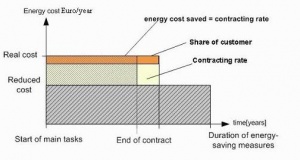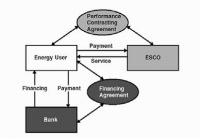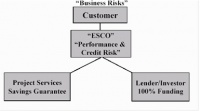ESCOs
Contents
- 1 Why regulation is necessary?
- 2 Energy service companies
- 3 Energy Performance Contracting (EPC)
- 4 Main characteristics of ESCOs and Energy Performance Contracting
- 5 Energy Performance Contract
- 6 Guaranteed savings and shared savings
- 7 Shared savings
- 8 Guaranteed savings
- 9 Experiences in other countries
Why regulation is necessary?
• Interests of third parties
• Environmental and culture issues
Energy service companies
Energy service companies (ESCOs) are important agents to promote energy efficiency Improvements. Although the European Commission and the Member States of the European Union (EU) have supported a number of policy initiatives to foster the ESCO industry, a recent survey of ESCO businesses in Europe has indicated that major differences exist in the development of the ESCO business among the various countries. This difference could be explained by several factors, such as different levels of support offered to ESCOs by national and regional energy authorities, local market structures and rules, and variation in the definitions, roles and activities of ESCOs. (Source:Institute for Environment and Sustainability, Renewable Energies Unit, PAOLO BERTOLDI AND SILVIA REZESSY, 3p)
Companies providing energy services to final energy users, including the supply and installation of energy-efficient equipment, the supply of energy, and/or building refurbishment, maintenance and operation, facility management, and the supply of energy (including heat), as Energy Service Provider Companies (ESPCs). They may be consulting engineers specialised in efficiency improvements, equipment manufacturers, energy suppliers or utilities. ESPCs provide a service for a fixed fee or as added value to the supply of equipment or energy.
Energy Service Companies (ESCOs) also offer these same services. ESCOs are fundamentally different from ESPCs and the ESCO activities can be distinguished from ESPCs’ activities in the following ways:
1. ESCOs guarantee the energy savings and/or the provision of the same level of energy service at a lower cost by implementing an energy efficiency project. A performance guarantee can take several forms. It can revolve around the actual flow of energy savings from a project, can stipulate that the energy savings will be sufficient to repay monthly debt service costs for an efficiency project, or that the same level of energy service will be provided for less money;
2. The remuneration of ESCOs is directly tied to the energy savings achieved;
3. ESCOs typically finance, or assist in arranging financing for the installation of an energy project they implement by providing a savings guarantee;
4. ESCOs retain an on-going operational role in measuring and verifying the savings over the financing term. Therefore ESCOs accept some degree of risk for the achievement of improved energy efficiency in a user’s facility and have their payment for the services delivered based (either in whole or at least in part) on the achievement of those energy efficiency improvements.(Source: ENERGY SERVICE COMPANIES IN EUROPE, European Commission, DG JRC,Institute for Environment and Sustainability,Renewable Energies Unit, PAOLO BERTOLDI AND SILVIA REZESSY, 17p)
Energy Performance Contracting (EPC)
Energy Performance Contracting (EPC) is a form of ‘creative financing’ for capital improvement which allows funding energy efficiency upgrades from cost reductions. The approach is based on the transfer of technical risks from the client to the ESCO based on performance guarantees given by the ESCO. In EPC, ESCO remuneration is based on demonstrated performance; a measure of performance is the level of energy or cost savings or the level of energy service. EPC is a means to deliver infrastructure improvements to facilities that lack energy engineering skills, manpower or management time, capital funding, understanding of risk, or technology information. Cash-poor, yet creditworthy, customers are therefore good potential clients for EPC.
Main characteristics of ESCOs and Energy Performance Contracting
An ESCO has the following key characteristics:
1. It guarantees the energy savings and/or provision of the same level of energy service at lower cost;
2. Its remuneration is directly tied to the energy savings achieved;
3. It can either finance, or assist in arranging financing for the installation of an energy project they implement by providing a savings guarantee.
Under an energy performance contracting (EPC) arrangement, an external organisation (ESCO) develops, implements and finances (or arranges financing of) an energy efficiency project or a renewable energy project, and uses the stream of income from the cost savings, or the renewable energy produced, to repay the costs of the project, including the costs of the investment. Essentially the ESCO will not recover all of its costs unless the project delivers all of the energy savings guaranteed.
Energy Performance Contract
- Note: Note that on this graph real cost refers to the initial cost, while the contracting rate depicts the cost savings which in this case are shared between the customer and the ESCO (see later the explanation on shared savings).
Source: Berlin Energy Agency
ESCO financing
ESCO financing refers to financing with internal funds of the ESCO and may involve use of its own capital or funding through other debt or lease instruments. ESCO rarely use equity for financing, as this options limits their capability of implementing projects on a sustainable basis.
Energy-user/customer financing
Energy-user/customer financing usually involves financing with internal funds of the user/customer backed by an energy savings guarantee provided by the ESCO (for instance, a university can use its endowment fund to finance an energy project, in which the energy savings are guaranteed by an ESCO). Energy-user/customer financing may also be associated with borrowing in the case when the energy-user/customer as a direct borrower has to provide a guarantee (collateral) to the finance institution.
Third-party financing (TPF)
Third-party financing (TPF) refers solely to debt financing. As its name suggests, project financing comes from a third party, e.g. a finance institution, and not from internal funds of the ESCO or of the customer. The finance institution may either assume the rights to the energy savings or may take a security interest in the project equipment (WEEA 1999). There are two conceptually different TPF arrangements associated with EPC; the key difference between them is which party borrows the money: the ESCO or the client.
The first option is that the ESCO borrows the financial resources necessary for project implementation.
The second option is that the energy-user/customer takes a loan from a finance institution, backed by an energy savings guarantee agreement with the ESCO. The purpose of the savings guarantee is to demonstrate to the bank that the project for which the customer borrows will generate a positive cash flow, i.e. that the savings achieved will certainly cover the debt repayment. Thus the energy savings guarantee reduces the risk perception of the bank, which has implications for the interest rates at which financing is acquired. The ‘cost of borrowing’ is strongly influenced by the size and credit history of the borrower.
Third party financing (TPF) with ESCO borrowing and with energy user/customer borrowing
The relationships and risk allocations among the ESCO, customer and lender in the two major performance contracting models: shared savings and guaranteed savings. Brief descriptions are also given.
Under a shared savings contract the cost savings are split for a pre-determined length of time in accordance with a pre-arranged percentage: there is no ‘standard’ split as this depends on the cost of the
project, the length of the contract and the risks taken by the ESCO and the consumer.
Guaranteed savings
Under a guaranteed savings contract the ESCO guarantees a certain level of energy savings and in this way shields the client from any performance risk.
An important difference between guaranteed and shared savings models is that in the former case the performance guarantee is the level of energy saved, while in the latter this is the cost of energy saved
(Hansen 2003, Poole and Stoner 2003).
Source: ENERGY SERVICE COMPANIES IN EUROPE, European Commission, DG JRC, Institute for Environment and Sustainability, Renewable Energies Unit, PAOLO BERTOLDI AND SILVIA REZESSY, 23p





